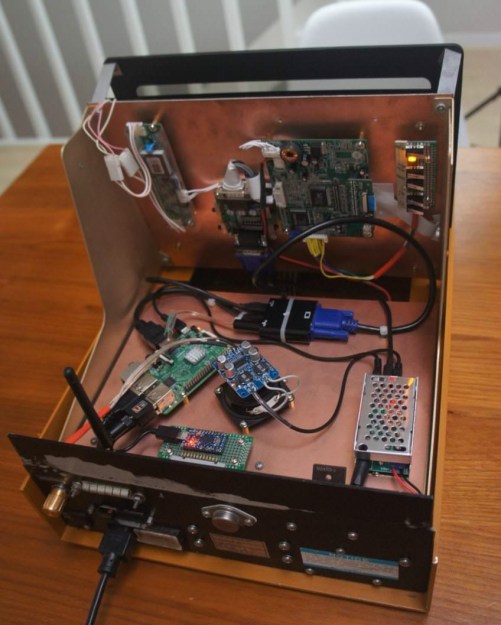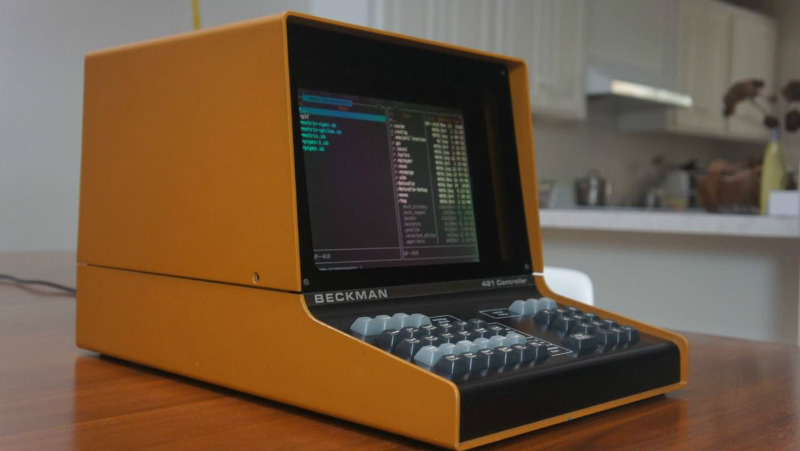When it was released, the Beckman Model 421 CRT controller represented the latest and greatest in liquid chromatography technology. Its 12 inch screen would allow the operator to view critical information such as flow rate and concentration, and its integrated keyboard simplified system control. It made liquid chromatography faster and easier, allowing lab technicians to focus on analysis rather than the complexities of operating the equipment.
 But none of that matters right now. What matters is that [Igor Afanasyev] found one of these gloriously vintage devices at a local swap meet and decided it deserved a second chance at life. With a Raspberry Pi and a surprising amount of support hardware, he was able to turn this roughly 40 year old piece of scientific equipment into a multipurpose device that does everything from classic gaming to multimedia playback. It’s got a few quirks, but overall this is a gadget that any hacker would love to have kicking around their modern-day lab.
But none of that matters right now. What matters is that [Igor Afanasyev] found one of these gloriously vintage devices at a local swap meet and decided it deserved a second chance at life. With a Raspberry Pi and a surprising amount of support hardware, he was able to turn this roughly 40 year old piece of scientific equipment into a multipurpose device that does everything from classic gaming to multimedia playback. It’s got a few quirks, but overall this is a gadget that any hacker would love to have kicking around their modern-day lab.
[Igor] explains that the Model 412 is essentially just a dumb terminal with no internal logic, so in theory it should have been possible to just hang the thing on a serial port and be done with it. But unfortunately the display drive board was dead, so a full rebuild was in order. This meant that there’s little left of the original device other than the keyboard and the case itself, but since it isn’t exactly a “vintage computer” in the traditional sense, we think the purists will allow it.
For the display, [Igor] used an LCD he salvaged from an old digital picture frame. It was the right size to fit the opening, and thanks to an unpopulated VGA header on the board, wasn’t too difficult to get connected to the Pi with an HDMI adapter. He also added a hardware VGA scanline generator board so that no matter what the Pi shows it will have that classic old-school look; a fantastic detail we don’t usually see on builds like this.
The keyboard on the Model 412 was more of a control panel than a traditional input device, so not only does it have keycaps which say things like “FLOW RATE” and “WRITE TAPE”, but it has a fairly weird layout. After reverse engineering the somewhat unusual key matrix, he spun up a custom firmware for the Arduino Pro Micro using QMK which would let him use the board on the Pi as a standard USB input device. But rather than replace the keys, [Igor] created a little cheat-sheet overlay that he could put over the board to see what keys translate to which letters. It’s awkward for sure, but we really appreciate that he preserved the unique nature and look of the Model 412.
Like the Heathkit H19 that was brought back to life with an internal Raspberry Pi or the DEC VT100 with a BealeBone inside there’s something about the visual aesthetic and no-nonsense approach of these vintage terminals which continue to make them compelling into the 21st century.
















Man that is a beautifully retro looking machine. There is something so special design wise about sheet metal only cases, where its nothing but some nice smooth bends, and a couple well placed screws. Makes me think of the early 60’s super computers.
Such a shame that most of these mods kill the old CRT… scanline generator or no scanline generator, nothing looks as good as the original glass tube.
Yea, these cheap LCDs don’t throw ionizing radiation at us like a real CRT ):
Yeah CRTs don’t really do that either.
https://www.ncbi.nlm.nih.gov/pubmed/25706133
After going through the leaded glass tube, it comes out to about 16 microsieverts / year.
The potassium inside your own body exposes you to 390 microsieverts / year.
http://imgs.xkcd.com/blag/radiation.png
And the above figure assumes you have your face pressed against the glass all year round. “Ionizing radiation” is a somewhat dramatic way of describing it. Being near a banana is going to do more damage.
Hi, Ionisation safety officer here!
Just dropping some additional knowledge. You can have upto a whole Sievert before you get near any recorded effects.
Nixie tubes aren’t that harmful as they’re encased in glass which reflects the more dangerous types of alpha radiation. Beta is only problematic if you have lead sources strapped to you
I wonder what it would’ve been like if that flat CRT tech had eventually come out before LCDs completely took over.
The Plato computer utilized the world’s first plasma display, so something like this?
https://upload.wikimedia.org/wikipedia/commons/e/ed/Platovterm1981.jpg
They still seemed to like putting it in a big, deep enclosure like a CRT would have, though.
That way you know it’s worth the amount of money they were asking for it. Kinda like how the Steam Link box had a chunk of metal in it to make it heavier.
Beats headphones are even worse. At least the argument could be made for the Steam Link that it needs some heft to keep from being dragged down by the HDMI cable (as happens to my Roku with a stiff/heavy cable).
https://www.digitaltrends.com/home-theater/beats-by-dre-headphones-teardown-finds-metal-parts-included-just-to-add-weight/
Agreed. It just doesn’t look right without the curved glass tube. It’s like a stuffed taxidermy animal compared to a real one. Or something. I don’t know if that analogy is working.
I’m currently working on a distraction-free writing station that keeps a CRT and a nice old terminal feeling. I mean the pi comes with composite out by default–why resort to a cheap LCD panel? This thing uses an HDMI-VGA adapter to talk LVDS through a generic LCD controller board which is bigger and probably more expensive than the pi. Why not just use the composite out and the tube? I guess color would get weird and the text hard to read.
Also I hope he puts a hole in the back for that wifi antenna to stick through. It’s probably not going to get great reception enclosed in a Faraday shield like that.
Screw CRTs. They’re the scourge of retro-computing. I’m glad I retrofited my 2nd Apple //c monitor because it was blown. Found it it’s missing stand and the results are so great, I’m itching to drive a hammer in my working one.
Plus the retrofit is colour—infinity better than green phosphor.
I wont purposely destroy one (otherwise that green goblin would have been gone ages ago) but CRTs, IMO, have defects I have a hard time dealing with:
– draw lots of power
– unnecessarily heavy
– present a shipping nightmare
– generate lots of heat
– fade over time
– phosphor burn-in
– smell
– static electricity buildup on tube
– near unmanageable sun glare.
– limited connectivity
I have a bunch of CRTs here that are still working but the amount of space they take is really annoying. It’s not to say I dont like the design of some of them. The //c, the NeXT 4000A, Apple Studio Display (17″ ADC) are works of art.
I just obtained a NeXT 4000A case and stand. It’s getting the LCD treatment.
“– draw lots of power
– unnecessarily heavy
– present a shipping nightmare
– generate lots of heat
– fade over time
– phosphor burn-in
– smell
– static electricity buildup on tube
– near unmanageable sun glare.
– limited connectivity”
Don’t be such a positivist!
List a few negatives while you’re at it.
lol why do you even enjoy retro computing at all? If you’re just going to go off a list of pros and cons, then obviously you should just use a modern machine. Literally the only reason to enjoy retro computing is to relive the quirks of that era. The CRT is part of that.
Why not just emulate on a laptop if you don’t care about the hardware? If you wanna get rid of your other Apple II monitor I’ll take it ;)
Of the ten things in your list, #s 1-4 and 10 are equally true of the computer attached to the CRT…
Great looking machine. The mustache photo looks straight out of the ’80’s :)
There is currently one one E-Bay and it includes everything for buy now of $150…mind you shipping cost may kill you.
https://www.ebay.com/itm/Beckman-liquid-chromatograph-w-2-110A-pumps-Detector-and-421-controller/263072273239?hash=item3d40545357:g:UHsAAOSwwvZZXEfn:rk:29:pf:0
Get’s me wanting to see if I can still have the free lab equipment offered to me twenty something years ago, i.e. AA with Zeeman furnace along with some other spectrometers that weren’t being used. Technically, an NMR, FTIR and Mass Spectrometer would be the unknown awesomeness kit. An ICP might be more beneficial also instead of an AA in a few cases. That can be added to the list. Add the GC/SAW Z-Nose system and I’m going off on a tangent again. Would be interesting to upgrade the software and maybe even the hardware on the older systems to improve performance specs and maybe reduce size of the system.
I’m thinking the retro systems have more a chance at meeting TEMPEST emission standards also.
What I like about this is the ‘period’ photo taken by the hacker. https://i.imgur.com/HYKzrSN.jpg
I’m wondering about how we are going to look in 50 years when we try to take photos of us doing retro projects from 2018….
Our grand kids will cosplay us in furry costumes
That’s awesome! I couldn’t find any Beckman 421’s on LabX https://www.labx.com but you might find some other old-school instruments to hack with; maybe a Waters 600 controller with CRT. Then someone has to hook it up to an old Kipp and Zonen chart recorder. https://www.labx.com/search?sw=KIPP+%26+ZONEN